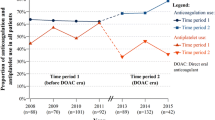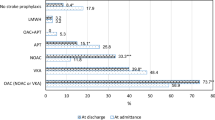Abstract
Background
Uncertainties about efficacy and safety of oral anticoagulant therapy (OAT) among older and frail medical patients with atrial fibrillation (AF) largely contribute to under-prescription of these drugs.
Aims
In this prospective observational cohort study, we investigated mortality, and ischemic and hemorrhagic events, in hospital-discharged older patients with AF.
Methods
Stroke and bleeding risk were evaluated using CHA2DS2-VASC and HAS-BLED scores. Comorbidity, frailty, cognitive and nutritional status and functional autonomy were evaluated using standardized scales. Independent associations between clinical variables, including OAT use, and all-cause mortality, fatal and non-fatal ischemic and hemorrhagic events, were evaluated. Further clinical outcomes comparison between patients treated with OAT and those untreated was performed after adjustment for significant differences in patient baseline characteristics with propensity score matching.
Results
Of 452 patients included (mean age 81.6 years, 54.9 % women, roughly 30 % cognitively impaired and/or functionally dependent, mean CHA2DS2-VASC and HAS-BLED scores 4.6 and 2.8, respectively), 151 (33.4 %) died during a mean follow-up period of 300.5 days; ischemic and hemorrhagic stroke occurred in 4.0 and 0.4 % of patients, respectively, and major bleedings in 6.2 %.
Discussion
After multivariate analysis, OAT at discharge was associated with lower overall mortality and reduced occurrence of ischemic stroke, the first finding being confirmed in propensity score matched analysis.
Conclusions
Among older vulnerable AF patients with high post discharge death rate, OAT was associated, among other multiple factors, with reduced mortality and lower occurrence of ischemic stroke.
Similar content being viewed by others
References
Sinnaeve PR, Brueckmann M, Clemens A et al (2012) Stroke prevention in elderly patients with atrial fibrillation: challenges for anticoagulation. J Intern Med 271:15–24. doi:10.1111/j.1365-2796
Chugh SS, Havmoeller R, Narayanan K et al (2014) Worldwide epidemiology of atrial fibrillation: a Global Burden of Disease 2010 Study. Circulation 129:837–847. doi:10.1161/CIRCULATIONAHA.113.005119
Mant J, Hobbs FD, Fletcher K et al (2007) Warfarin versus aspirin for stroke prevention in an elderly community population with atrial fibrillation (the Birmingham Atrial Fibrillation Treatment of the Aged Study, BAFTA): a randomised controlled trial. Lancet 370:493–503. doi:10.1016/S0140-6736(07)61233-1
Singer DE, Chang Y, Fang MC et al (2009) The net clinical benefit of warfarin anticoagulation in atrial fibrillation. Ann Intern Med 151:297–305
Olesen JB, Lip GY, Lindhardsen J et al (2011) Risks of thromboembolism and bleeding with thromboprophylaxis in patients with atrial fibrillation: a net clinical benefit analysis using a ‘real world’ nationwide cohort study. Thromb Haemost 106:739–749. doi:10.1160/TH11-05-0364
Friberg L, Rosenqvist M, Lip GY (2012) Net clinical benefit of warfarin in patients with atrial fibrillation: a report from the Swedish atrial fibrillation cohort study. Circulation 125:2298–2307. doi:10.1161/CIRCULATIONAHA.111.055079
Siu CW, Tse HF (2014) Net clinical benefit of warfarin therapy in elderly Chinese patients with atrial fibrillation. Circ Arrhythm Electrophysiol 7:300–306. doi:10.1161/CIRCEP.113.000858
Hylek EM, D’Antonio J, Evans-Molina C et al (2006) Translating the results of randomized trials into clinical practice: the challenge of warfarin candidacy among hospitalized elderly patients with atrial fibrillation. Stroke 37:1075–1080. doi:10.1161/01.STR.0000209239.71702.ce
Pugh D, Pugh J, Mead GE (2011) Attitudes of physicians regarding anticoagulation for atrial fibrillation: a systematic review. Age Ageing 40:675–683. doi:10.1093/ageing/afr097
Di Pasquale G, Mathieu G, Maggioni AP et al (2013) Current presentation and management of 7148 patients with atrial fibrillation in cardiology and internal medicine hospital centers: the ATA AF study. Int J Cardiol 167:2895–2903. doi:10.1016/j.ijcard.2012.07.019
Abdul-Rahim AH, Wong J, McAlpine C et al (2014) Associations with anticoagulation: a cross-sectional registry-based analysis of stroke survivors with atrial fibrillation. Heart 100:557–562. doi:10.1136/heartjnl-2013-305267
Bo M, Li Puma F, Badinella-Martini M et al (2015) Health status, geriatric syndromes, and prescription of oral anticoagulant therapy in elderly medical in-patients with atrial fibrillation: a prospective observational study. Int J Cardiol 187:123–125. doi:10.1016/j.ijcard.2015.03.334
Sánchez-Barba B, Navarrete-Reyes AP, Avila-Funes JA (2013) Are geriatric syndromes associated with reluctance to initiate oral anticoagulation therapy in elderly adults with non-valvular atrial fibrillation? J Am Geriatr Soc 61:2236–2237. doi:10.1111/jgs.12582
Gage BF, Birman-Deych E, Kerzner R et al (2005) Incidence of intracranial hemorrhage in patients with atrial fibrillation who are prone to fall. Am J Med 118:612–617. doi:10.1016/j.amjmed.2005.02.022
Poli D, Antonucci E, Grifoni E et al (2009) Bleeding risk during oral anticoagulation in atrial fibrillation patients older than 80 years. J Am Coll Cardiol 54:999–1002. doi:10.1016/j.jacc.2009.05.046
Poli D, Antonucci E, Testa S et al (2011) Bleeding risk in very old patients on vitamin K antagonist treatment: results of a prospective collaborative study on elderly patients followed by Italian Centres for Anticoagulation. Circulation 124:824–829. doi:10.1161/CIRCULATIONAHA.110.007864
Bo S, Valpreda S, Scaglione L, Boscolo D et al (2007) Implementing hospital guidelines improves warfarin use in non-valvular atrial fibrillation: a before-after study. BMC Public Health 7:203. doi:10.1186/1471-2458-7-203
Bo M, Massaia M, Raspo S et al (2003) Predictive factors of in-hospital mortality in older patients admitted to a medical intensive care unit. J Am Geriatr Soc 51:529–533
Sona A, Maggiani G, Astengo M et al (2012) Determinants of recourse to hospital treatment in the elderly. Eur J Public Health 22:76–80. doi:10.1093/eurpub/ckr008
Bo M, Martini B, Ruatta C et al (2009) Geriatric ward hospitalization reduced incidence delirium among older medical inpatients. Am J Geriatr Psychiatry 17:760–768. doi:10.1016/S0140-6736(07)61233-1
Kirchhof P, Ammentorp B, Darius H et al (2014) Management of atrial fibrillation in seven European countries after the publication of the 2010 ESC Guidelines on atrial fibrillation: primary results of the PREvention oF thromboemolic events—European Registry in Atrial Fibrillation (PREFER in AF). Europace 16:6–14. doi:10.1093/europace/eut263
Lip GY, Laroche C, Dan GA et al (2014) A prospective survey in European Society of Cardiology member countries of atrial fibrillation management: baseline results of EURObservational Research Programme Atrial Fibrillation (EORP-AF) Pilot General Registry. Europace 16:308–319. doi:10.1093/europace/eut373
Jacobs LG, Billett HH, Freeman K et al (2009) Anticoagulation for stroke prevention in elderly patients with atrial fibrillation, including those with falls and/or early-stage dementia: a single-center, retrospective, observational study. Am J Geriatr Pharmacother 7:159–166. doi:10.1016/j.amjopharm.2009.06.002
Pamukcu B, Lip GY, Lane DA (2010) Simplifying stroke risk stratification in atrial fibrillation patients: implications of the CHA2DS2-VASc risk stratification scores. Age Ageing 39:533–535. doi:10.1093/ageing/afq059
Pisters R, Lane DA, Nieuwlaat R et al (2010) A novel user-friendly score (HAS-BLED) to assess 1-year risk of major bleeding in patients with atrial fibrillation: the Euro Heart Survey. Chest 138:1093–1100. doi:10.1378/chest.10-0134
Lip GY, Frison L, Halperin JL et al (2011) Comparative validation of a novel risk score for predicting bleeding risk in anticoagulated patients with atrial fibrillation: the HAS-BLED (Hypertension, Abnormal Renal/Liver Function, Stroke, Bleeding History or Predisposition, Labile INR, Elderly, Drugs/Alcohol Concomitantly) score. J Am Coll Cardiol 57:173–180. doi:10.1016/j.jacc.2010.09.024
Charlson ME, Pompei P, Ales KL et al (1987) A new method of classifying prognostic comorbidity in longitudinal studies: development and validation. J Chronic Dis 40:373–383
Pfeiffer E (1975) A short portable mental status questionnaire for the assessment of organic brain deficit in elderly patients. J Am Geriatr Soc 23:433–441
Katz S, Downs TD, Cash HR et al (1970) Progress in development of the index of ADL. Gerontologist 10:20–30
Lawton MP, Brody EM (1969) Assessment of older people: self-maintaining and instrumental activities of daily living. Gerontologist 9:179–186
Sheikh JI, Yesavage JA (1986) geriatric depression scale (GDS) recent evidence and development of a shorter version. In: Brink TL (ed) Clinical gerontology : a guide to assessment and intervention. The Haworth Press, New York, pp 165–173
Yesavage JA, Brink TL, Rose TL et al (1982) Development and validation of a geriatric depression screening scale: a preliminary report. J Psychiatr Res 17:37–49
Steverink N, Slaets JPJ, Schuurmans H et al (2001) Measuring frailty: development and testing of the groningen frailty indicator (GFI). Gerontol 41:236–237
Guigoz Y, Vellas B, Garry PJ (1996) Assessing the nutritional status of the elderly: the mini nutritional assessment as part of the geriatric evaluation. Nutr Rev 54:S59–S65
Conley D, Schultz AA, Selvin R (1999) The challenge of predicting patients at risk for falling: development of the Conley Scale. Medsurg Nurs 8:348–354
Sacco RL, Kasner SE, Broderick JP et al (2013) An updated definition of stroke for the 21st century: a statement for healthcare professionals from the American Heart Association/American Stroke Association. Stroke 44:2064–2089. doi:10.1161/STR.0b013e318296aeca
Schulman S, Kearon C (2005) Definition of major bleeding in clinical investigations of antihemostatic medicinal products in non-surgical patients. Subcommittee on Control of Anticoagulation of the Scientific and Standardization Committee of the International Society on Thrombosis and Haemostasis. J Thromb Haemost 3:692–694. doi:10.1111/j.1538-7836.2005.01204.x
Hernandez I, Baik SH, Piñera A et al (2015) Risk of bleeding with dabigatran in atrial fibrillation. JAMA Intern Med 175:18–24. doi:10.1001/jamainternmed.2014.5398
Author information
Authors and Affiliations
Corresponding author
Ethics declarations
Conflict of interest
On behalf of all authors, the corresponding author states that there is no conflict of interest.
Ethical approval
The study was conducted according to the principles of the Declaration of Helsinki Title 45, U.S. Code of Federal Regulations, Part 46, Protection of Human Subjects, Revised November 13, 2001, effective December 13, 2001. Signed informed consent at admission was obtained for all participants and the study was conducted according to the Recommendations Guiding Physicians in Biomedical research Involving Human Subjects.
Informed consent
Informed consent was obtained from all individual participants included in the study.
Rights and permissions
About this article
Cite this article
Bo, M., Li Puma, F., Badinella Martini, M. et al. Effects of oral anticoagulant therapy in older medical in-patients with atrial fibrillation: a prospective cohort observational study. Aging Clin Exp Res 29, 491–497 (2017). https://doi.org/10.1007/s40520-016-0569-7
Received:
Accepted:
Published:
Issue Date:
DOI: https://doi.org/10.1007/s40520-016-0569-7




